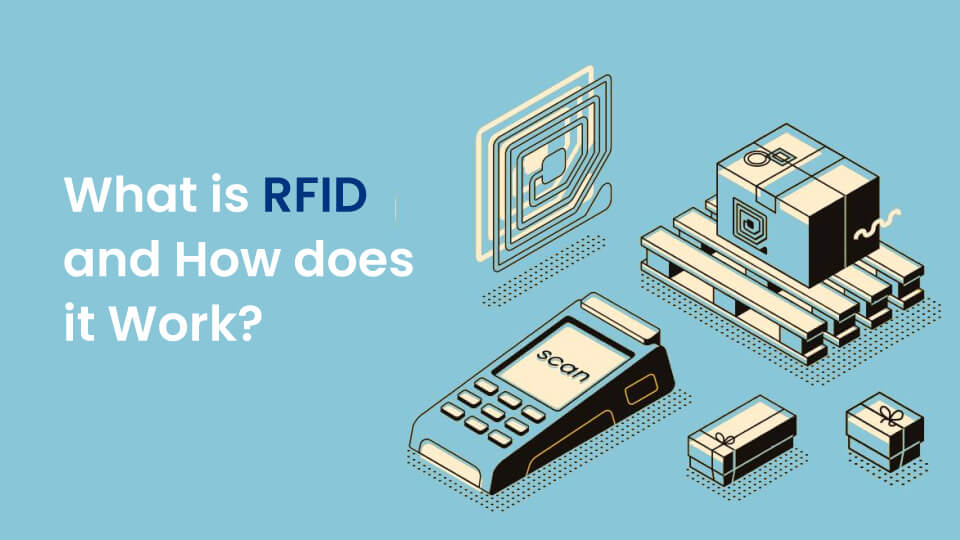
What is RFID and How does it Work?
Many industries use Radio Identification Frequency, or RFID. Implementing this technology automates and streamlines inventory management, minimizes manual errors, and empowers businesses with a full grip over their inventories. There are a few industries in particular where it has become inevitable- retail, healthcare, logistics, and automotive. What is RFID, and how it can help transport and logistics industry? Let’s delve into the details.
1. What is RFID?
Radio Frequency Identification is a process used to track an object with the help of radio transmission. It is a form of wireless communication generated from the confluence of electromagnetic or electrostatic coupling in the radio frequency part of the electromagnetic spectrum.
2. How does it Work?
Every RFID-powered system comprises a scanning antenna, a transceiver, and a transponder. When one combines the scanning antenna with the transceiver, it is called an RFID reader or interrogator. It has two types of readers- mobile readers and fixed readers.
The mobile reader is dynamic while its tags are fixed. It does not need wires to set the reader to cover a large area.
A fixed reader is stationary. One can attach it to a portal or mount it on a wall or ceiling.
RFID-reader is a network-connected device. It deploys radio waves to transmit signals that can activate the tag. When the tag is active, it sends a wave to the antenna, and the antenna transforms it into data. It is available in both portable and fixed forms.
3. Tags and Smart Levels
Tags are an essential part of RFID technology. These tags comprise an Integrated Circuit or IC, antenna, and substrate. Some portions of the tag encode the identifying information. There are two types of tags:
A.Active Tag
It is an active RFID tag with a power source, sometimes a battery.
B.Passive Tag
It derives power from the reading antenna. Its electromagnetic wave generates a current in the antenna of the RFID tag.
Some semi-passive RFID tags also exist. These tags have a battery running in the circuitry while the reader empowers communication.
Low-power and non-volatile memory play a vital role in the RFID system. Tags usually retain less than 2,000 KB of data and a unique identifier or serial number. Tags are either read-only or read-write, where one can add data with the reader or with the existing overwritten data.
The read range for RFID applications may vary depending on a couple of factors, such as the type of the tag and reader, frequency, and interference in the surrounding environment. Comparatively, active tags possess a more extended read range than passive ones.
Tags need more advanced devices. Smart labels are nothing but simple tags embedded into a single adhesive label, and they can feature a barcode. You can print these labels on-demand with desktop printers.
4. Types of Tags
There are three critical RFID systems, low frequency (LF), high frequency (HF), and ultra-high frequency (UHF). Microwaves can also be available. Frequencies, however, may differ by country and region.
Listed below are the vital types of RFID systems:
A.Low-frequency RFID systems
These types range from 30 kHz to 500 kHz, while the regular frequency is 125 kHz. LF RFID contains short transmission ranges ranging from a few inches to less than 6 ft.
B.High-frequency systems
High-frequency systems range from 3 MHz to 30 MHz, as HF frequency is 13.56 MHz. You can find the standard range anywhere from a few inches to several feet.
C.UHF systems
UHF systems range from 300 MHz to 960 MHz. Its usual frequency ranges from 433 MHz. Anyone can read it anywhere from 25+ feet away.
D.Microwave systems
Microwave systems run at 2.45 GHz and can read from 30+ feet away.
5. What are the Challenges?
When it comes to RFID, two challenges need special mention. These two critical challenges are:
A.Reader Collision
Reader collision occurs when a signal from one reader interferes with another. To avoid such collisions, you can use an anti-collision protocol. It will make the tags get transmitted to the right reader.
B.Tag Collision
Tag collision happens when multiple tags make RFID-readers confused by transferring data at the same time. To prevent such collisions, you can pick a reader that gathers tag information one at a time.
6. Use Cases and Applications
The concept is not new. It dates back to the 1940s. It became popular in the 1970s. For an extended period, its use was limited due to the high cost of the tags and readers. With the decrease in hardware costs, its application has increased rapidly. Listed below are some of its vital usages:
A.Tracking pet and livestock
B.Managing inventory
C.Monitoring assets and devices
D.Handling cargo and supply chain logistics
E.Tracking and maintaining vehicles
F.Enhanced supply chain visibility and distribution system
Stay One Step ahead of your Competitors with RFID Technology
Most businesses need to maintain an inventory. If you are running a business and need to pay attention to your existing list, you can consider RFID. It will make inventory and supply chain management easier for you. Moreover; it will significantly increase the efficiency of your logistics operations.
You may Find the Following Articles Helpful
5 Amazing Benefits of Logistics Management Apps
Everything You Need To Know About Logistics Management Systems




